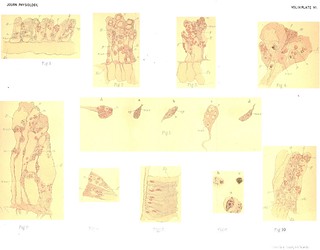- External URL
- Creation
-
Creator (Definite): Marion Greenwood BidderDate: 1894
- Current Holder(s)
-
nb: full journal title Philosophical Transactions of the Royal Society of London B.
- No links match your filters. Clear Filters
-
Cited by
 An Amoeboid Theatre: Marion Greenwood Bidder's physiological research at Cambridge (1879-1899)
An Amoeboid Theatre: Marion Greenwood Bidder's physiological research at Cambridge (1879-1899)
Description:'By 1894, Greenwood had developed her [dye-feeding] technique in relation to the infusoria - an article from her research on which would appear in the prestigious Philosophical Transactions of the Royal Society. The renowned German physiologist Max Verworn replicated Greenwood's main figure for this piece in the second edition of his Allgemeine Physiologie (1897) noting that the study (which he assumed had been conducted by a man) was both ‘very interesting’ and ‘outstanding’.'
-
Cited by
 M. Verworn, Allgemeine Physiologie: ein Grundriss der Lehre vom Leben (2nd ed.) (Jena, 1897).
M. Verworn, Allgemeine Physiologie: ein Grundriss der Lehre vom Leben (2nd ed.) (Jena, 1897).
Description:159
-
Cited by
 T. Quick, Minute Mediation: Cell Physiology, Print-Making and Industry in Late Victorian Cambridge
T. Quick, Minute Mediation: Cell Physiology, Print-Making and Industry in Late Victorian Cambridge
Description:'Greenwood fixed her attention as much on the ingestion of difficult-to-observe organisms as on such bright materials as Indian ink and carmine. But even when observing these former, dyes and stains performed a critical function. In one example, an amoeba had, after six days' observation, been seen to extend a funnel-like projection around a seemingly abandoned vacuole containing 'five extremely small [translucent] Monads and one readily distinguishable carmine grain'. Having re-assimilated these bodies, the amoeba began to digest its prey; 'at 3.30 P.M... all trace of the Monads had gone.; and at 4.30 P.M. it [the vacuole]... was indistinguishable except by memory from an Infusorian holding carmine.'[1] Having been 'ingested together with carmine... colouring matter' enabled Greenwood to follow the 'decrease... in size' of Monads as they were assimilated into the bodies of their new-found hosts.[2]'







